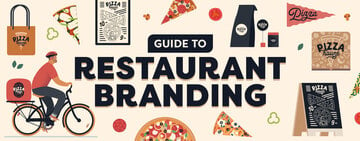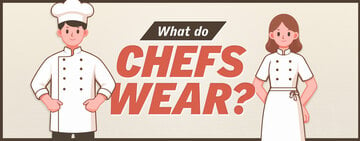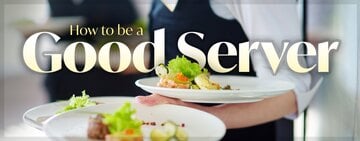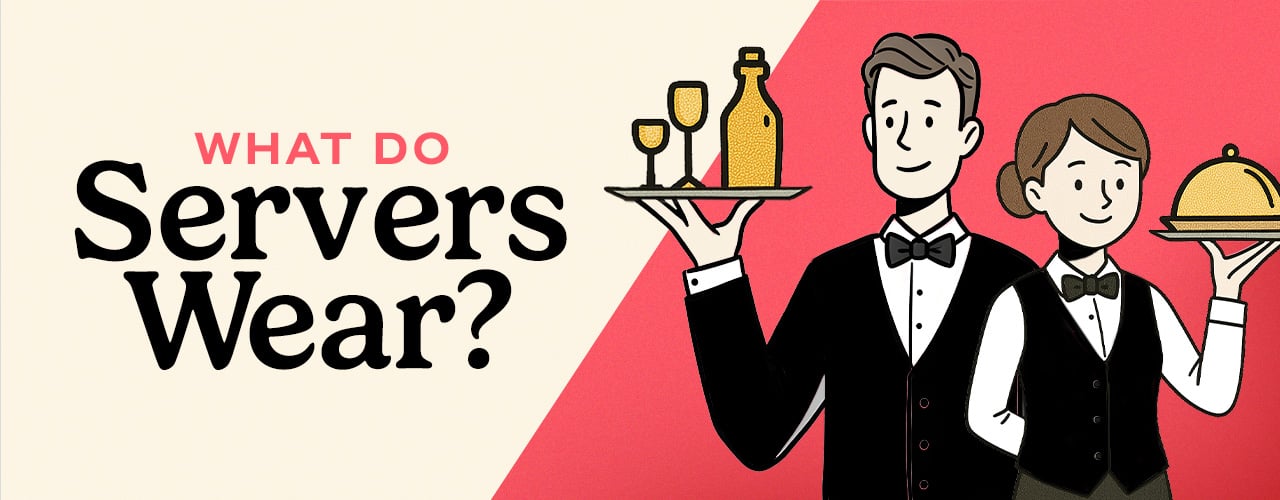
While the quality of the food determines whether customers will return, the service received by waitstaff heavily affects brand loyalty. Training your servers well equips them to charm patrons and upsell your menu, but dressing them well helps them make a good impression before they've said a word. What servers wear depends on the type of restaurant they work in and the demands of their role within it. We've created a guide to the different pieces of a server's dress code so you can put together an ensemble befitting your establishment.
Shop All Server ClothingWaiter Dress Code
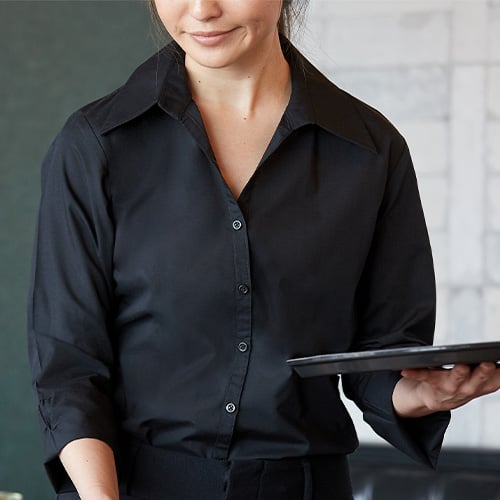
A cohesive and professional waiter dress code creates a consistent and polished appearance among your staff. This enhances the overall dining experience for customers and ensures your waitstaff feel confident and comfortable in their attire. Here are some general tips for crafting an effective waiter dress code:
- Consider Your Restaurant's Theme: Your dress code should align with the overall ambiance and theme of your restaurant. Whether you opt for a formal, casual, or themed dress code, it should coincide with the type of restaurant you're operating.
- Prioritize Comfort and Functionality: While appearance is important, comfort and functionality should not be overlooked. Choose breathable fabrics for ease of movement.
- Ensure Uniformity: Consistency is key for a dress code. Establish clear guidelines on the specific pieces of clothing that are required, such as shirts, pants, skirts, aprons, and shoes, to maintain a unified look among your staff.
- Incorporate Branding Elements: Use your dress code as an opportunity to reinforce your brand identity through customized clothing. Consider incorporating elements such as logo embroidery, color schemes, or specific accessories that reflect your restaurant's branding.
- Provide Guidelines on Grooming and Hygiene: In addition to clothing, establish standards for grooming and hygiene, including hair styling, facial hair grooming, and personal hygiene practices. These guidelines contribute to a professional appearance and overall cleanliness.
- Account for Seasonal Changes: Consider seasonal variations in temperature and weather when designing your dress code. Provide options for layering during colder months and consider breathable fabrics for summer.
- Allow for Personalization: While maintaining a uniform appearance is important, consider allowing some room for personalization within the dress code. This could involve offering a selection of approved accessories or allowing for individual preferences within specified guidelines to make staff feel valued and reduce turnover.
- Seek Feedback from Staff: Involve your waitstaff in the dress code creation process by seeking their input and feedback. Understanding their preferences and comfort levels can help tailor the dress code to meet both aesthetic and practical needs and help you keep your best employees.
Server Hairstyles
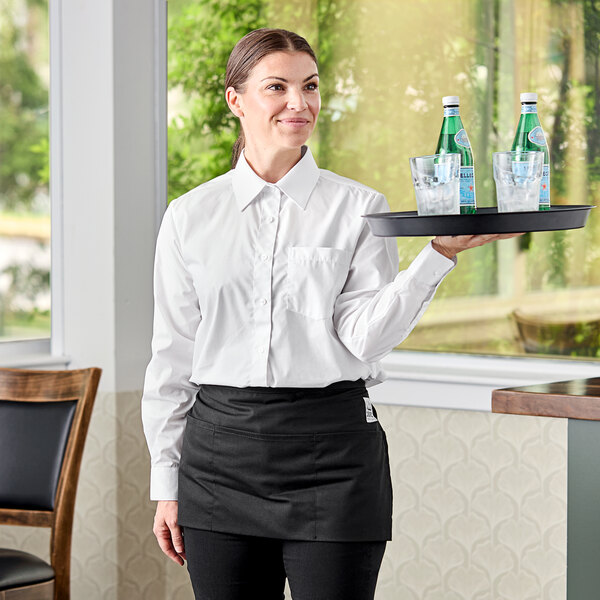
Unlike a server uniform, which is universal for all your staff, hairstyles will vary. However, there are hygiene practices you must enforce and general guidelines you can provide to ensure waitstaff present a clean, polished appearance.
- Hair Hygiene: Servers must clean, groom, and regularly trim their hair. Regular washing, styling, and hair health can help maintain a polished look that reflects positively on the establishment.
- Hair Length: In many restaurants, there are guidelines regarding the length of hair for servers. Longer hair is often tied back or styled in a way that keeps it away from food and the customer's view.
- Hair Accessories: Simple and understated hair accessories, such as hair clips or headbands, can help keep hair in place during service. Choose functional hair accessories that complement the overall uniform.
- Hair Color: Some restaurants, like fine dining establishments, have regulations regarding hair color. Upscale dining typically requires servers to have natural shades and prohibits bright and unnatural colors.
Server Jackets

Servers in fine dining establishments and upscale casual dining often wear server jackets to maintain a high level of professionalism and sophistication. These restaurants aim to create a more elevated dining atmosphere compared to casual eateries, and the use of server jackets helps to convey this level of service and attention to detail.
- Suit Jacket: For a classic and polished look, suit jackets are typically tailored and come in a variety of colors and styles to match the overall theme of the restaurant.
- Tuxedo Jacket: A more formal choice for upscale dining establishments or catered events, tuxedo jackets are distinguished by their satin lapels and buttons, adding an elegant touch to the server's attire.
- Blazer: Offering a more relaxed and contemporary look while still maintaining a level of professionalism, blazers come in various fabrics and colors to suit different restaurant atmospheres.
- Eton Jacket: The cropped length and fitted silhouette of the Eton jacket give it a modern and sophisticated appearance, perfect for establishments with a high-end ambiance.
Server Shirts
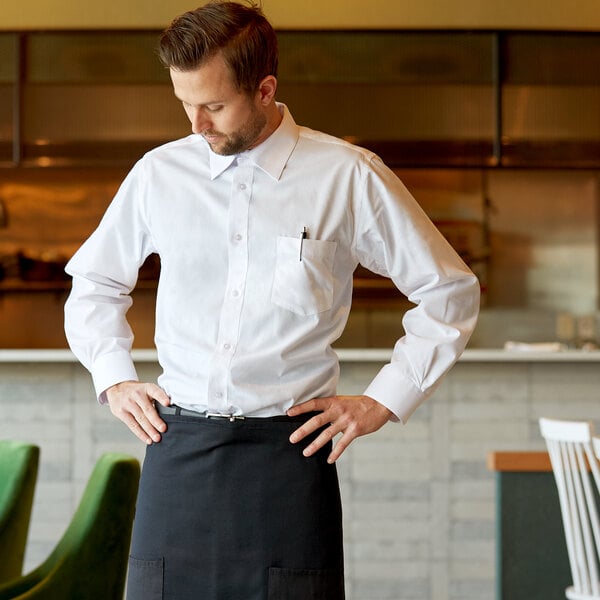
Selecting the appropriate server shirts is crucial in maintaining a professional appearance while ensuring comfort and functionality throughout the shift. Here are some common server shirt styles:
- Button-Down Dress Shirts: A classic, polished choice for waiters and waitresses in upscale dining establishments, button-down dress shirts can be either short-sleeved or long-sleeved, providing options for different seasons and preferences.
- Polo Shirts: Typically short-sleeved and made of a comfortable fabric, polo shirts are a popular choice for more casual dining establishments or outdoor dining settings.
- Dress Shirts: Typically made of cotton or a cotton blend, dress shirts offer a comfortable and breathable fabric, and they can be paired with a tie for a more formal look or worn on their own in casual settings.
- Brewer Shirts: Commonly seen in bars, breweries, and casual dining establishments, brewer shirts are typically short-sleeved and may feature unique designs or logos related to the establishment's brand or theme.
Server Vests

Server vests come in a variety of styles and colors to suit different restaurant atmospheres. Explore types of server vests to determine which complements your dining room's aesthetic:
- Extended Length Server Vests: These vests typically feature a longer cut, closing the gap between the vest and the pants and adding a touch of sophistication to servers' uniforms.
- Customizable Server Vests: Personalize servers' vests to align with your brand identity by adding embroidered logos, unique color combinations, or specific design details.
- Colored Server Vests: Restaurants looking to incorporate a specific color scheme into their server uniforms can opt for vests in colors like purple, red, green, and navy to create a cohesive visual aesthetic that complements the overall ambiance.
- Satin Server Vests: The smooth texture and subtle sheen of satin fabric elevate the look of server vests for fine dining establishments that prioritize elegance and sophistication.
- Polyester Server Vests: The wrinkle-resistant and moisture-wicking properties of polyester make polyester server vests a durable and easy-to-care-for option for restaurants seeking practicality and longevity in their server uniforms.
- Adjustable Server Vests: Providing a comfortable and flexible fit for servers of varying body types, adjustable server vests have adjustable straps or buckles to ensure a snug and flattering fit for all staff members.
- Reversible Server Vests: With two different colors or patterns on each side, reversible vests provide a convenient way to change up the look of server uniforms without purchasing multiple pieces.
Server Pants

Server pants offer both functionality and style. Here are some common types of server pants and the restaurants that commonly use them:
- Adjustable Comfort Waist Pants: These pants feature an adjustable waistband for a comfortable fit throughout long shifts, making them ideal for restaurants that prioritize comfort and flexibility for their servers, such as casual diners and family-friendly eateries.
- Flat Front Pants: The clean lines and tailored appearance of flat front pants add a touch of sophistication to the server's uniform, making them an ideal choice for upscale dining establishments, fine dining restaurants, and banquet halls.
- Low-Cut Pants: Designed to sit lower on the waist, low-cut pants offer a modern and stylish silhouette, complementing the overall aesthetic of restaurants with a trendy and contemporary ambiance, such as hip cafes, modern bistros, and fusion restaurants.
- Machine Washable Pants: Casual dining chains, fast-casual restaurants, and high-volume establishments appreciate the convenience of machine-washable server pants that maintain their quality even after repeated washings.
- Satin Side Stripe Pants: Featuring a decorative satin trim along the sides, satin side stripe pants add a touch of elegance to the server's attire at upscale restaurants, luxury hotels, and formal dining venues.
- Poly-Twill Pants: The blend of polyester and twill fabric offers wrinkle-resistance and durability, making poly-twill pants ideal for high-traffic establishments such as casual dining restaurants, diners, and fast-casual eateries.
- Poly-Wool Pants: Combining the comfort of polyester with the classic look of wool, poly-wool pants provide a sophisticated appearance while offering ease of movement and breathability, and are often chosen for formal dining settings where a more refined uniform is required.
- Polyester Pants: Known for their durability, lightweight, and color retention, polyester pants are a low-maintenance option for fast-paced restaurants, cafes, and catering events.
Server Aprons

Each type of server apron serves a specific purpose and contributes to the overall appearance and functionality of the front of house staff in different restaurant settings.
- 4-Way Waist Apron: Ideal for casual dining restaurants and cafes, the 4-way waist apron's reversible, multi-functional design allows servers to quickly switch between clean sides during busy shifts, keeping them looking professional throughout the day.
- Bib Apron: By providing full coverage for the front of the body, bib aprons protect clothing from spills and stains, making them a functional choice in settings where servers handle messy tasks or work with food and for bussers clearing tables.
- Bistro Apron: Shorter in length than traditional aprons, bistro aprons offer a more casual and modern look that balances style and functionality for bistros, coffee shops, and upscale bars.
- Tuxedo Apron: Featuring a sleek and formal design that resembles a tuxedo, tuxedo aprons are often chosen for upscale dining environments where a polished and sophisticated look is desired.
- Utility Pouch Apron: Equipped with multiple pockets and compartments for storing essential tools and accessories, utility pouch aprons are practical for servers who need quick access to items while on the job, such as food trucks, outdoor events, and family dining establishments.
- Waist Apron: Facilitating ease of movement and quick access to items, waist aprons tie around the waist and provide coverage for the lower half of the body, and are suitable for bars, pubs, and casual dining establishments.
Server Shoes

The type of commercial-grade shoes worn by servers can vary based on the restaurant's atmosphere, the level of formality, and the nature of the work environment.
- Classic Black Dress Shoes: Providing a professional and elegant look for servers working in upscale settings, these shoes are typically made of leather and have a sleek, polished appearance.
- Non-Slip Shoes: Essential for servers working in environments where spills and wet surfaces are common, like fast-food chains, non-slip shoes have slip-resistant soles to prevent accidents and ensure safety.
- Clogs: Easy to slip on and off, clogs are convenient, durable, and provide good arch support, making them suitable for servers who are constantly on the move in a cafe, coffee shop, or bakery.
- Steel-Toe Shoes: Designed to withstand impact and provide added safety in high-risk settings like brewery pubs, industrial kitchens, and catering services, steel-toe shoes offer extra protection for servers working in environments where there is a risk of heavy objects falling on their feet.
- Sneakers: Perfect for food trucks, outdoor events, and casual dining establishments, sneakers help servers navigate different terrains and spend long hours on their feet.
Server Accessories
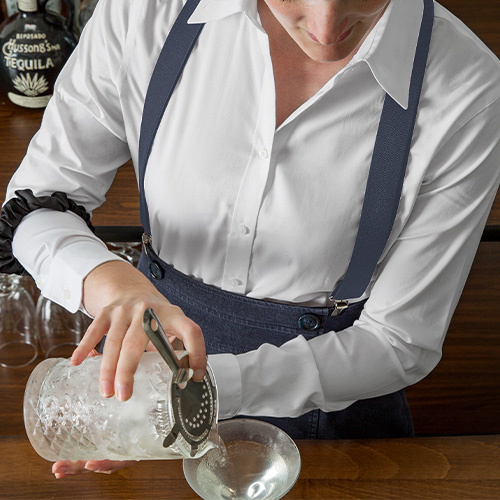
Finalize your servers' uniforms with these common accessories. From practical accessories like belts to aesthetic touches like bow ties, server accessories pull the look together.
- Belts: A practical accessory that not only adds a touch of professionalism to a server's uniform but also keeps their pants securely in place, many upscale restaurants and fine dining establishments require servers to wear belts as part of their uniform to maintain a polished appearance.
- Bow Ties: Commonly worn by servers in upscale restaurants, formal dining establishments, and high-end catering events, bow ties add a touch of charm and refinement to a server's uniform.
- Gloves: Cloth server gloves provide an upscale alternative to plastic for servers working in fine dining restaurants, banquet halls, and catering events.
- Ties: From casual dining establishments to upscale eateries, ties add a touch of professionalism to a server's uniform, making them a popular choice for restaurants that aim to create a polished and refined dining experience for their guests.
- Cufflinks: While not always a mandatory part of a server's attire, cufflinks are often seen in upscale restaurants, luxury hotels, and formal dining establishments where attention to detail and a sense of style are valued.
- Cummerbund: Worn around the waist, the cummerbund is a wide waistband covering the area between the waist and the chest that is usually made of silk or satin material to complement the overall uniform or theme of the upscale dining establishment.
- Suspenders: Often worn in retro-themed restaurants, speakeasies, and establishments that embrace a classic and nostalgic ambiance, suspenders serve both a functional and aesthetic purpose by keeping pants in place while adding a touch of vintage charm to a server's uniform.
Back to Top
Server Uniform FAQ
Now that you're familiar with the elements of a server's uniform, we answer common questions about waiter dress codes below:
What Do Waiters Wear Around Their Waists?
One of the most common items worn around the waist by waiters is an apron. Aprons come in various styles, including waist aprons that tie around the waist and full-length aprons that provide more coverage. Waiters may wear utility belts around their waist to carry essential tools such as pens, order pads, and wine keys. In cafes and casual eateries, waiters often wear money pouches or waist bags to hold cash and credit card receipts during their shifts.
Why Do Waiters Wear Black?
In a restaurant setting, where the focus is on providing a high-quality dining experience, black uniforms help create a polished and elegant look for the staff. Black clothing can be accessorized with aprons, ties, or other accents to add a touch of individuality while still maintaining a professional appearance. The color black is also known for its ability to hide stains and spills, which are common occurrences in a fast-paced restaurant environment.
Black uniforms offer a cohesive and uniform look for the entire serving staff. When all servers wear the same color, it creates a sense of unity and consistency in the restaurant's overall aesthetic. This uniformity can also help customers easily identify and distinguish the waitstaff from other restaurant employees, such as kitchen staff or management.
Do Servers Have to Wear Their Hair Up?
In many food service establishments, servers are required to wear their hair up to maintain a clean and hygienic environment, prevent hair from contacting the food, and ensure hair does not interfere with the service process. For servers who are required to wear their hair up, there are various ways to achieve this look. Common methods include wearing a bun, a ponytail, or a braid.
Many establishments allow servers to wear their hair down as long as it is kept tidy. In these cases, servers may be required to use hair accessories or products to keep their hair in place and prevent it from falling into food or becoming a safety hazard. Ultimately, the decision of whether servers have to wear their hair up depends on the specific dress code policies of the establishment they work for. Servers must familiarize themselves with the employee handbook's policies and ensure they comply.
In the fast-paced and customer-centric environment of the hospitality industry, the attire of servers plays a crucial role in shaping the overall dining experience. A server's uniform not only reflects the establishment's brand and image but also influences how customers perceive the level of service they are likely to receive. By maintaining a polished and consistent appearance, servers can instill confidence in patrons and create a positive first impression that sets the tone for a memorable dining experience.



